Assignment (Doc) | Career Path of Crime Lab Analyst
VerifiedAdded on 2022/10/07
|7
|1487
|23
Assignment
AI Summary
The two career choices I would like discussed are a crime lab analyst and a victim's advocate.
Contribute Materials
Your contribution can guide someone’s learning journey. Share your
documents today.

Running head: MANAGEMENT
MANAGEMENT
Name of the Student:
Name of the University:
Author note:
MANAGEMENT
Name of the Student:
Name of the University:
Author note:
Secure Best Marks with AI Grader
Need help grading? Try our AI Grader for instant feedback on your assignments.
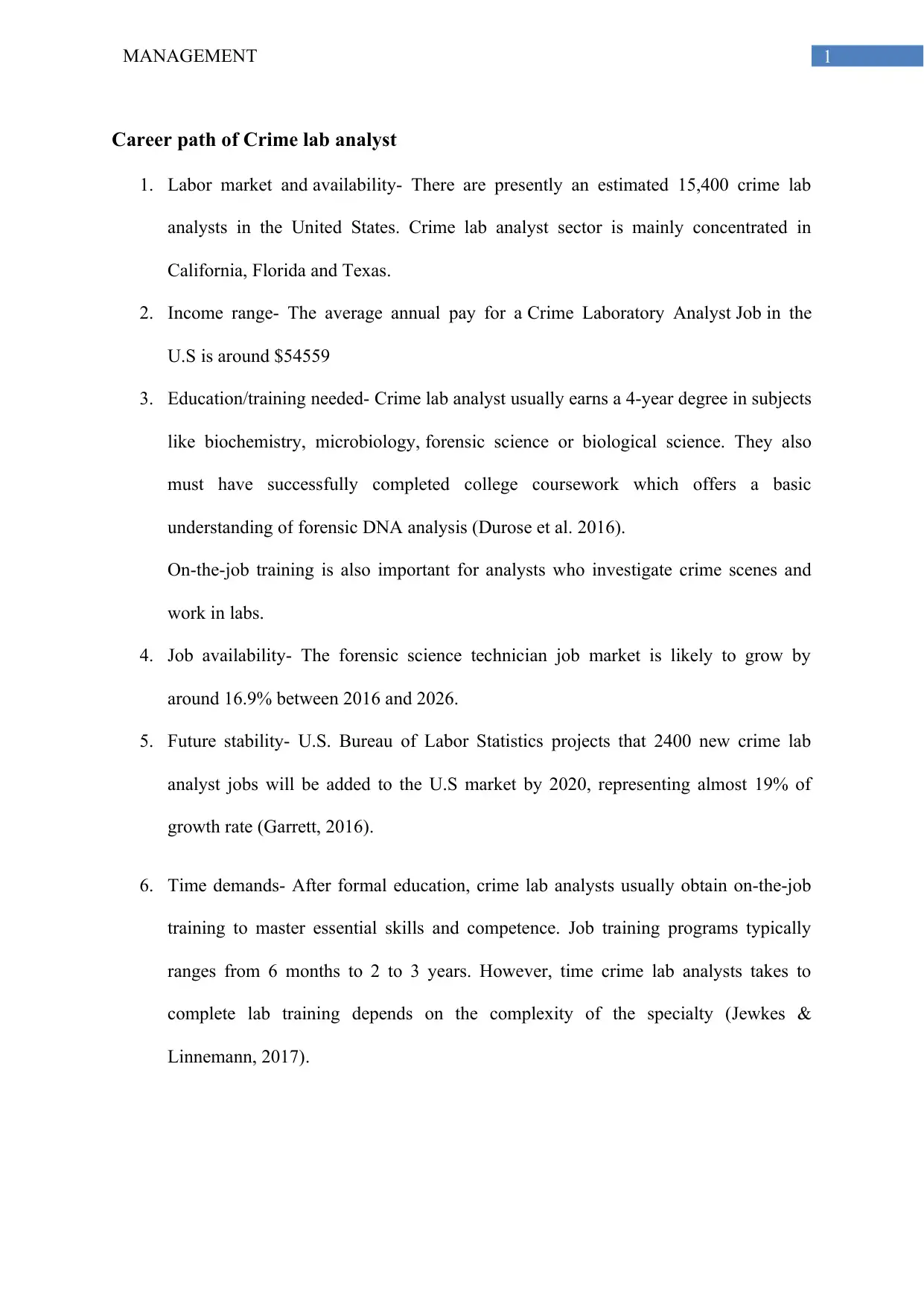
1MANAGEMENT
Career path of Crime lab analyst
1. Labor market and availability- There are presently an estimated 15,400 crime lab
analysts in the United States. Crime lab analyst sector is mainly concentrated in
California, Florida and Texas.
2. Income range- The average annual pay for a Crime Laboratory Analyst Job in the
U.S is around $54559
3. Education/training needed- Crime lab analyst usually earns a 4-year degree in subjects
like biochemistry, microbiology, forensic science or biological science. They also
must have successfully completed college coursework which offers a basic
understanding of forensic DNA analysis (Durose et al. 2016).
On-the-job training is also important for analysts who investigate crime scenes and
work in labs.
4. Job availability- The forensic science technician job market is likely to grow by
around 16.9% between 2016 and 2026.
5. Future stability- U.S. Bureau of Labor Statistics projects that 2400 new crime lab
analyst jobs will be added to the U.S market by 2020, representing almost 19% of
growth rate (Garrett, 2016).
6. Time demands- After formal education, crime lab analysts usually obtain on-the-job
training to master essential skills and competence. Job training programs typically
ranges from 6 months to 2 to 3 years. However, time crime lab analysts takes to
complete lab training depends on the complexity of the specialty (Jewkes &
Linnemann, 2017).
Career path of Crime lab analyst
1. Labor market and availability- There are presently an estimated 15,400 crime lab
analysts in the United States. Crime lab analyst sector is mainly concentrated in
California, Florida and Texas.
2. Income range- The average annual pay for a Crime Laboratory Analyst Job in the
U.S is around $54559
3. Education/training needed- Crime lab analyst usually earns a 4-year degree in subjects
like biochemistry, microbiology, forensic science or biological science. They also
must have successfully completed college coursework which offers a basic
understanding of forensic DNA analysis (Durose et al. 2016).
On-the-job training is also important for analysts who investigate crime scenes and
work in labs.
4. Job availability- The forensic science technician job market is likely to grow by
around 16.9% between 2016 and 2026.
5. Future stability- U.S. Bureau of Labor Statistics projects that 2400 new crime lab
analyst jobs will be added to the U.S market by 2020, representing almost 19% of
growth rate (Garrett, 2016).
6. Time demands- After formal education, crime lab analysts usually obtain on-the-job
training to master essential skills and competence. Job training programs typically
ranges from 6 months to 2 to 3 years. However, time crime lab analysts takes to
complete lab training depends on the complexity of the specialty (Jewkes &
Linnemann, 2017).
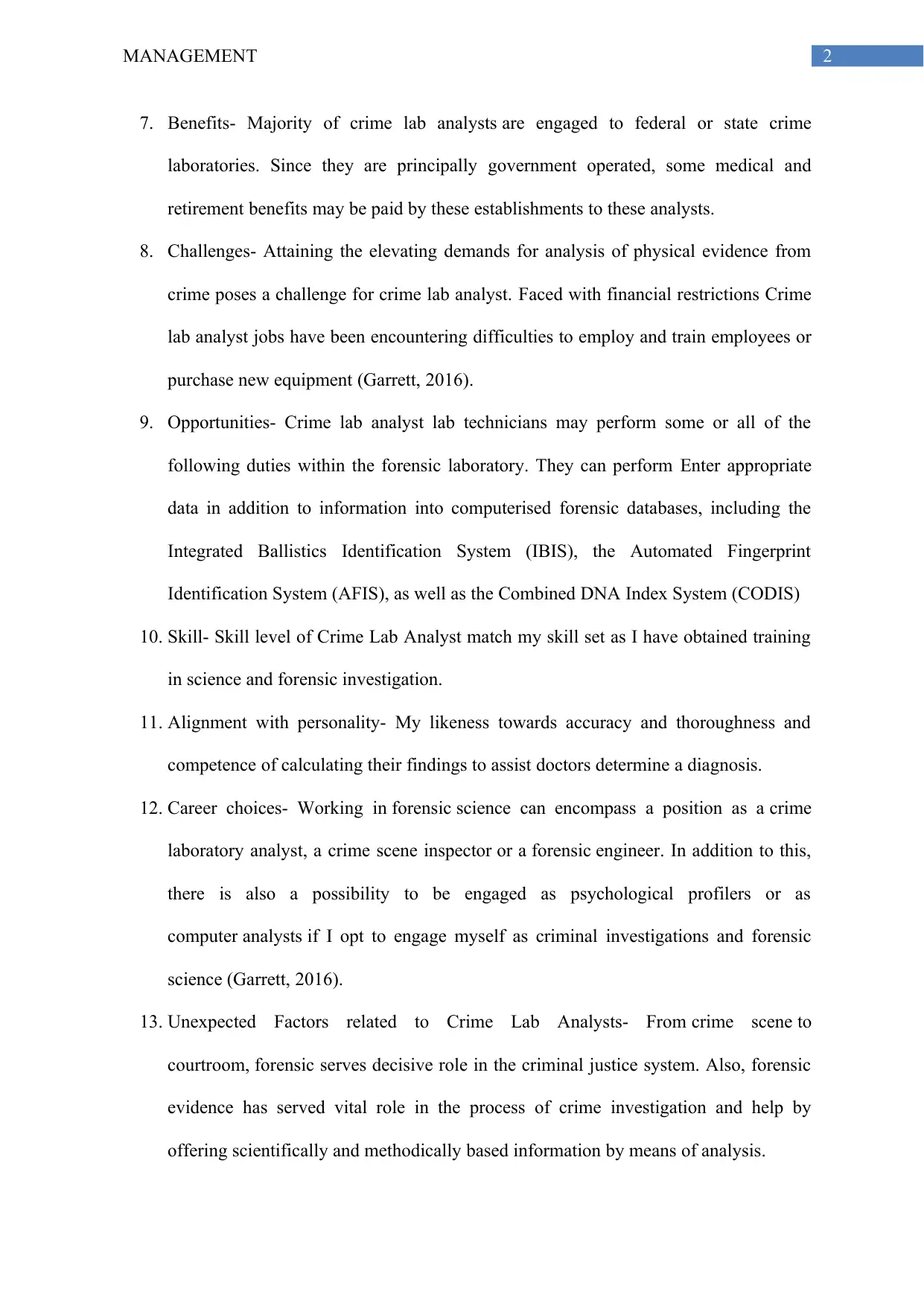
2MANAGEMENT
7. Benefits- Majority of crime lab analysts are engaged to federal or state crime
laboratories. Since they are principally government operated, some medical and
retirement benefits may be paid by these establishments to these analysts.
8. Challenges- Attaining the elevating demands for analysis of physical evidence from
crime poses a challenge for crime lab analyst. Faced with financial restrictions Crime
lab analyst jobs have been encountering difficulties to employ and train employees or
purchase new equipment (Garrett, 2016).
9. Opportunities- Crime lab analyst lab technicians may perform some or all of the
following duties within the forensic laboratory. They can perform Enter appropriate
data in addition to information into computerised forensic databases, including the
Integrated Ballistics Identification System (IBIS), the Automated Fingerprint
Identification System (AFIS), as well as the Combined DNA Index System (CODIS)
10. Skill- Skill level of Crime Lab Analyst match my skill set as I have obtained training
in science and forensic investigation.
11. Alignment with personality- My likeness towards accuracy and thoroughness and
competence of calculating their findings to assist doctors determine a diagnosis.
12. Career choices- Working in forensic science can encompass a position as a crime
laboratory analyst, a crime scene inspector or a forensic engineer. In addition to this,
there is also a possibility to be engaged as psychological profilers or as
computer analysts if I opt to engage myself as criminal investigations and forensic
science (Garrett, 2016).
13. Unexpected Factors related to Crime Lab Analysts- From crime scene to
courtroom, forensic serves decisive role in the criminal justice system. Also, forensic
evidence has served vital role in the process of crime investigation and help by
offering scientifically and methodically based information by means of analysis.
7. Benefits- Majority of crime lab analysts are engaged to federal or state crime
laboratories. Since they are principally government operated, some medical and
retirement benefits may be paid by these establishments to these analysts.
8. Challenges- Attaining the elevating demands for analysis of physical evidence from
crime poses a challenge for crime lab analyst. Faced with financial restrictions Crime
lab analyst jobs have been encountering difficulties to employ and train employees or
purchase new equipment (Garrett, 2016).
9. Opportunities- Crime lab analyst lab technicians may perform some or all of the
following duties within the forensic laboratory. They can perform Enter appropriate
data in addition to information into computerised forensic databases, including the
Integrated Ballistics Identification System (IBIS), the Automated Fingerprint
Identification System (AFIS), as well as the Combined DNA Index System (CODIS)
10. Skill- Skill level of Crime Lab Analyst match my skill set as I have obtained training
in science and forensic investigation.
11. Alignment with personality- My likeness towards accuracy and thoroughness and
competence of calculating their findings to assist doctors determine a diagnosis.
12. Career choices- Working in forensic science can encompass a position as a crime
laboratory analyst, a crime scene inspector or a forensic engineer. In addition to this,
there is also a possibility to be engaged as psychological profilers or as
computer analysts if I opt to engage myself as criminal investigations and forensic
science (Garrett, 2016).
13. Unexpected Factors related to Crime Lab Analysts- From crime scene to
courtroom, forensic serves decisive role in the criminal justice system. Also, forensic
evidence has served vital role in the process of crime investigation and help by
offering scientifically and methodically based information by means of analysis.
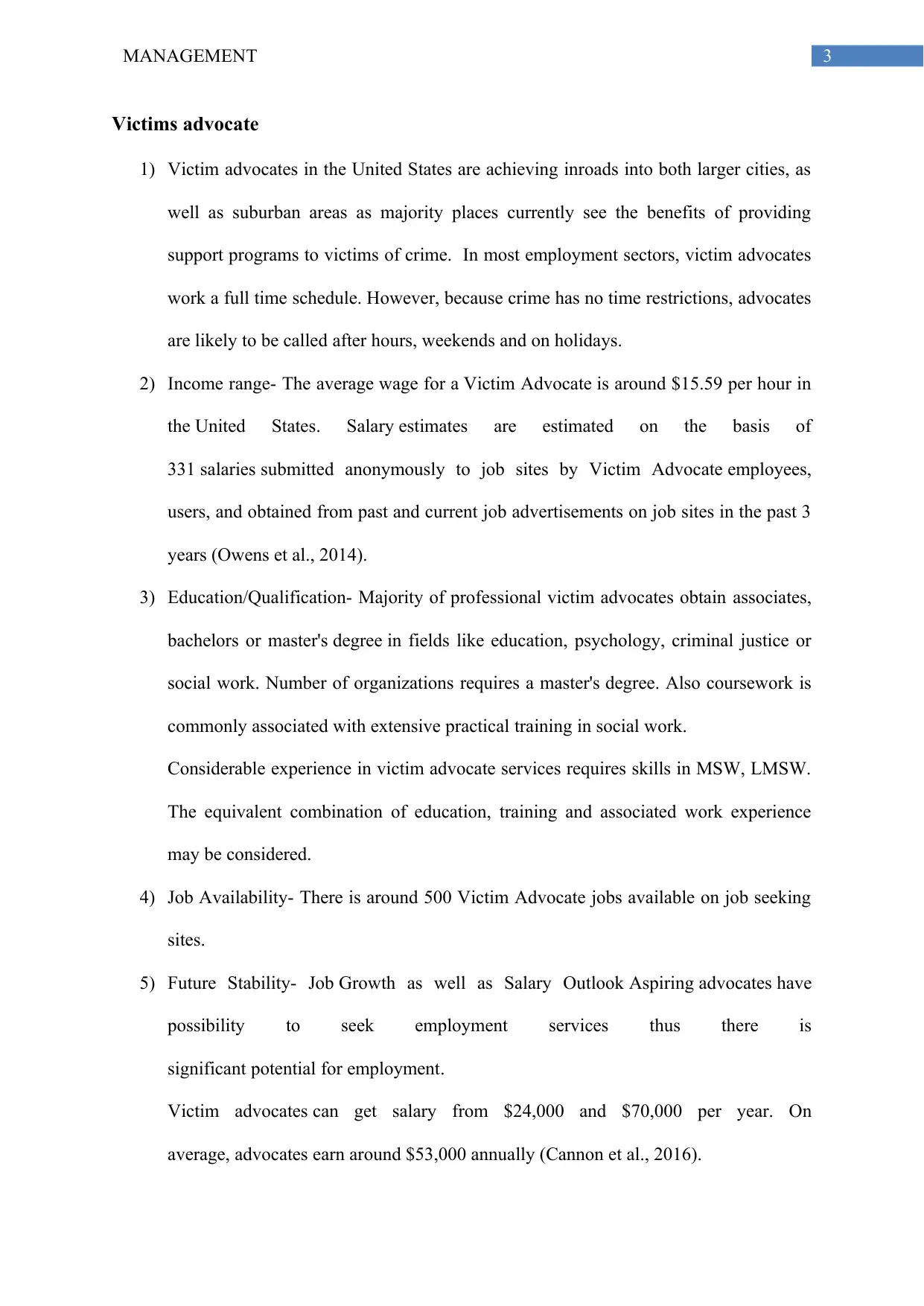
3MANAGEMENT
Victims advocate
1) Victim advocates in the United States are achieving inroads into both larger cities, as
well as suburban areas as majority places currently see the benefits of providing
support programs to victims of crime. In most employment sectors, victim advocates
work a full time schedule. However, because crime has no time restrictions, advocates
are likely to be called after hours, weekends and on holidays.
2) Income range- The average wage for a Victim Advocate is around $15.59 per hour in
the United States. Salary estimates are estimated on the basis of
331 salaries submitted anonymously to job sites by Victim Advocate employees,
users, and obtained from past and current job advertisements on job sites in the past 3
years (Owens et al., 2014).
3) Education/Qualification- Majority of professional victim advocates obtain associates,
bachelors or master's degree in fields like education, psychology, criminal justice or
social work. Number of organizations requires a master's degree. Also coursework is
commonly associated with extensive practical training in social work.
Considerable experience in victim advocate services requires skills in MSW, LMSW.
The equivalent combination of education, training and associated work experience
may be considered.
4) Job Availability- There is around 500 Victim Advocate jobs available on job seeking
sites.
5) Future Stability- Job Growth as well as Salary Outlook Aspiring advocates have
possibility to seek employment services thus there is
significant potential for employment.
Victim advocates can get salary from $24,000 and $70,000 per year. On
average, advocates earn around $53,000 annually (Cannon et al., 2016).
Victims advocate
1) Victim advocates in the United States are achieving inroads into both larger cities, as
well as suburban areas as majority places currently see the benefits of providing
support programs to victims of crime. In most employment sectors, victim advocates
work a full time schedule. However, because crime has no time restrictions, advocates
are likely to be called after hours, weekends and on holidays.
2) Income range- The average wage for a Victim Advocate is around $15.59 per hour in
the United States. Salary estimates are estimated on the basis of
331 salaries submitted anonymously to job sites by Victim Advocate employees,
users, and obtained from past and current job advertisements on job sites in the past 3
years (Owens et al., 2014).
3) Education/Qualification- Majority of professional victim advocates obtain associates,
bachelors or master's degree in fields like education, psychology, criminal justice or
social work. Number of organizations requires a master's degree. Also coursework is
commonly associated with extensive practical training in social work.
Considerable experience in victim advocate services requires skills in MSW, LMSW.
The equivalent combination of education, training and associated work experience
may be considered.
4) Job Availability- There is around 500 Victim Advocate jobs available on job seeking
sites.
5) Future Stability- Job Growth as well as Salary Outlook Aspiring advocates have
possibility to seek employment services thus there is
significant potential for employment.
Victim advocates can get salary from $24,000 and $70,000 per year. On
average, advocates earn around $53,000 annually (Cannon et al., 2016).
Secure Best Marks with AI Grader
Need help grading? Try our AI Grader for instant feedback on your assignments.
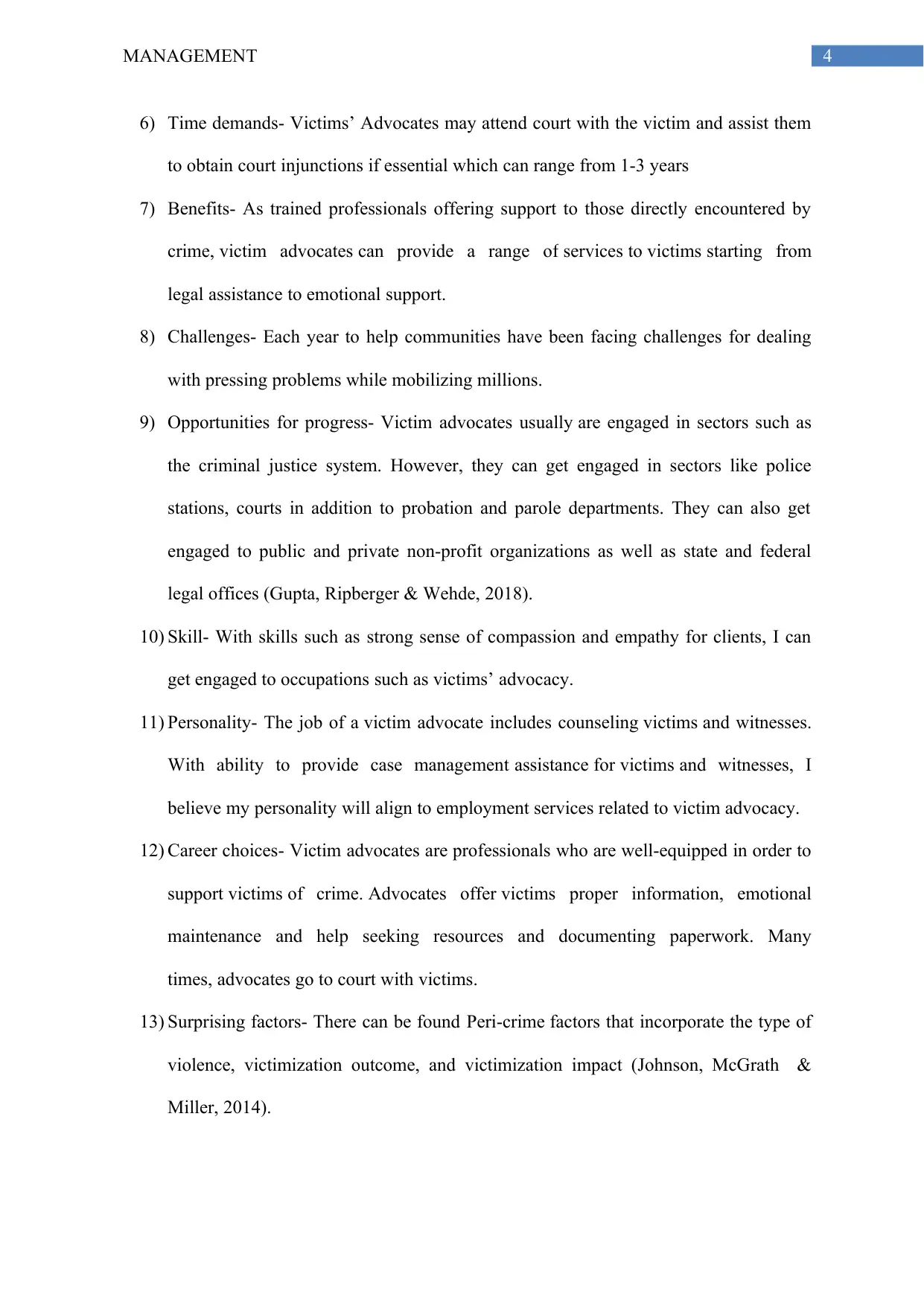
4MANAGEMENT
6) Time demands- Victims’ Advocates may attend court with the victim and assist them
to obtain court injunctions if essential which can range from 1-3 years
7) Benefits- As trained professionals offering support to those directly encountered by
crime, victim advocates can provide a range of services to victims starting from
legal assistance to emotional support.
8) Challenges- Each year to help communities have been facing challenges for dealing
with pressing problems while mobilizing millions.
9) Opportunities for progress- Victim advocates usually are engaged in sectors such as
the criminal justice system. However, they can get engaged in sectors like police
stations, courts in addition to probation and parole departments. They can also get
engaged to public and private non-profit organizations as well as state and federal
legal offices (Gupta, Ripberger & Wehde, 2018).
10) Skill- With skills such as strong sense of compassion and empathy for clients, I can
get engaged to occupations such as victims’ advocacy.
11) Personality- The job of a victim advocate includes counseling victims and witnesses.
With ability to provide case management assistance for victims and witnesses, I
believe my personality will align to employment services related to victim advocacy.
12) Career choices- Victim advocates are professionals who are well-equipped in order to
support victims of crime. Advocates offer victims proper information, emotional
maintenance and help seeking resources and documenting paperwork. Many
times, advocates go to court with victims.
13) Surprising factors- There can be found Peri-crime factors that incorporate the type of
violence, victimization outcome, and victimization impact (Johnson, McGrath &
Miller, 2014).
6) Time demands- Victims’ Advocates may attend court with the victim and assist them
to obtain court injunctions if essential which can range from 1-3 years
7) Benefits- As trained professionals offering support to those directly encountered by
crime, victim advocates can provide a range of services to victims starting from
legal assistance to emotional support.
8) Challenges- Each year to help communities have been facing challenges for dealing
with pressing problems while mobilizing millions.
9) Opportunities for progress- Victim advocates usually are engaged in sectors such as
the criminal justice system. However, they can get engaged in sectors like police
stations, courts in addition to probation and parole departments. They can also get
engaged to public and private non-profit organizations as well as state and federal
legal offices (Gupta, Ripberger & Wehde, 2018).
10) Skill- With skills such as strong sense of compassion and empathy for clients, I can
get engaged to occupations such as victims’ advocacy.
11) Personality- The job of a victim advocate includes counseling victims and witnesses.
With ability to provide case management assistance for victims and witnesses, I
believe my personality will align to employment services related to victim advocacy.
12) Career choices- Victim advocates are professionals who are well-equipped in order to
support victims of crime. Advocates offer victims proper information, emotional
maintenance and help seeking resources and documenting paperwork. Many
times, advocates go to court with victims.
13) Surprising factors- There can be found Peri-crime factors that incorporate the type of
violence, victimization outcome, and victimization impact (Johnson, McGrath &
Miller, 2014).
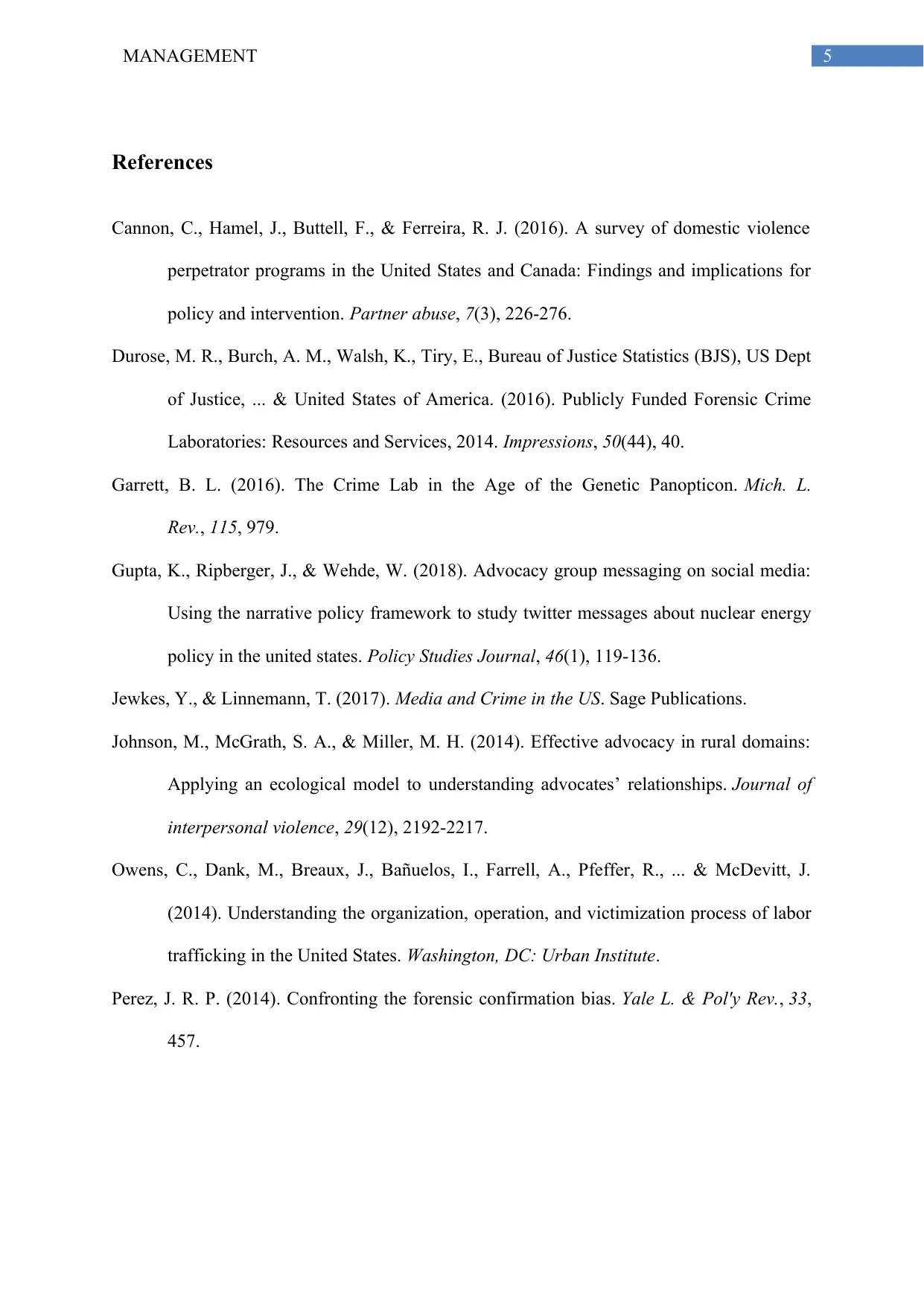
5MANAGEMENT
References
Cannon, C., Hamel, J., Buttell, F., & Ferreira, R. J. (2016). A survey of domestic violence
perpetrator programs in the United States and Canada: Findings and implications for
policy and intervention. Partner abuse, 7(3), 226-276.
Durose, M. R., Burch, A. M., Walsh, K., Tiry, E., Bureau of Justice Statistics (BJS), US Dept
of Justice, ... & United States of America. (2016). Publicly Funded Forensic Crime
Laboratories: Resources and Services, 2014. Impressions, 50(44), 40.
Garrett, B. L. (2016). The Crime Lab in the Age of the Genetic Panopticon. Mich. L.
Rev., 115, 979.
Gupta, K., Ripberger, J., & Wehde, W. (2018). Advocacy group messaging on social media:
Using the narrative policy framework to study twitter messages about nuclear energy
policy in the united states. Policy Studies Journal, 46(1), 119-136.
Jewkes, Y., & Linnemann, T. (2017). Media and Crime in the US. Sage Publications.
Johnson, M., McGrath, S. A., & Miller, M. H. (2014). Effective advocacy in rural domains:
Applying an ecological model to understanding advocates’ relationships. Journal of
interpersonal violence, 29(12), 2192-2217.
Owens, C., Dank, M., Breaux, J., Bañuelos, I., Farrell, A., Pfeffer, R., ... & McDevitt, J.
(2014). Understanding the organization, operation, and victimization process of labor
trafficking in the United States. Washington, DC: Urban Institute.
Perez, J. R. P. (2014). Confronting the forensic confirmation bias. Yale L. & Pol'y Rev., 33,
457.
References
Cannon, C., Hamel, J., Buttell, F., & Ferreira, R. J. (2016). A survey of domestic violence
perpetrator programs in the United States and Canada: Findings and implications for
policy and intervention. Partner abuse, 7(3), 226-276.
Durose, M. R., Burch, A. M., Walsh, K., Tiry, E., Bureau of Justice Statistics (BJS), US Dept
of Justice, ... & United States of America. (2016). Publicly Funded Forensic Crime
Laboratories: Resources and Services, 2014. Impressions, 50(44), 40.
Garrett, B. L. (2016). The Crime Lab in the Age of the Genetic Panopticon. Mich. L.
Rev., 115, 979.
Gupta, K., Ripberger, J., & Wehde, W. (2018). Advocacy group messaging on social media:
Using the narrative policy framework to study twitter messages about nuclear energy
policy in the united states. Policy Studies Journal, 46(1), 119-136.
Jewkes, Y., & Linnemann, T. (2017). Media and Crime in the US. Sage Publications.
Johnson, M., McGrath, S. A., & Miller, M. H. (2014). Effective advocacy in rural domains:
Applying an ecological model to understanding advocates’ relationships. Journal of
interpersonal violence, 29(12), 2192-2217.
Owens, C., Dank, M., Breaux, J., Bañuelos, I., Farrell, A., Pfeffer, R., ... & McDevitt, J.
(2014). Understanding the organization, operation, and victimization process of labor
trafficking in the United States. Washington, DC: Urban Institute.
Perez, J. R. P. (2014). Confronting the forensic confirmation bias. Yale L. & Pol'y Rev., 33,
457.

6MANAGEMENT
1 out of 7
Your All-in-One AI-Powered Toolkit for Academic Success.
+13062052269
info@desklib.com
Available 24*7 on WhatsApp / Email
![[object Object]](/_next/static/media/star-bottom.7253800d.svg)
Unlock your academic potential
© 2024 | Zucol Services PVT LTD | All rights reserved.